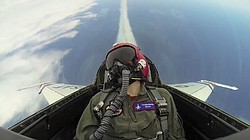Pulling G’s on a Thunderbird
Soaring Thunder

With the roar of jet engines and the sight of billowing clouds above, reporter Kalea Hall of The Vindicator takes to the skies with the Air Force Thunderbirds.
By Kalea Hall
VIENNA
“Here comes the G.”
Those four words will never leave my mind after my experience Friday on a Thunderbird at the Youngstown-Warren Air Reserve Station.
I can still hear myself breathing, smell the rubber of the mask I had to wear and the sights — imagine a blanket of puffy clouds beneath you, around you and above you.
Simply put, it was like heaven.
I know I experienced a once-in-a-lifetime trip, so here is my shot at explaining this extraordinary flight.
It wasn’t when I was suspended above the ground that I started to feel nervous.
And it wasn’t when it felt like a small elephant was sitting on my chest.
It was when Maj. Michael Fisher, advance pilot and narrator for the Air Force Thunderbirds, used a model F-16 to dictate what maneuvers the jet would actually do when I felt the nerves kick in.
I remember briefly flashing back to when I asked my boss if I could fly. I anticipated this flight from the moment I found out about it and even more so after finding out Wednesday I could fly.
I had to remind myself in those few moments when the nerves started to kick in that I would most likely never have this chance again, and that my grandfather would have been proud and probably jealous like most of my family and friends.
I grew up surrounded by a love and appreciation for planes. My grandfather, Charles Mound, built his own. In fact, my grandparents met working at the airport. So, it is safe to say that the love of planes is what made my existence possible.
Before the flight, I was given the essentials: a flight suit, patches, including the Thunderbird patch, an “anti-G” suit, a parachute harness and a bright red helmet.
Of course, I had to have the talk about motion sickness and “pulling G’s.” A “G” is a gravitational force, which is a measurement of acceleration felt as weight. The force of gravity on earth is 1 G. On a Thunderbird, you can go up to 9 G’s and down to -3 G’s. Obviously, your body will be affected by that force, including the blood in your body wanting to go to lower parts of the body.
Maj. Michael Carletti, flight surgeon, gave me pointers. He explained I needed to make sure I kept blood flow to my brain so I did not pass out.
The anti-G suit inflated when we “pulled G’s,” helping to prevent the blood from flowing to the lower parts of my body in addition to me squeezing my muscles.
“If you aren’t shaking, you’re not squeezing hard enough,” Carletti told me.
Then I learned how to breathe in a “Ka” sound, wait three seconds and then breathe again while pulling G’s.
Now, it was time to fly.
The air was damp and cold. I found myself already shaking before I even hopped into the cockpit.
I told myself I would not give up, and most importantly, I would not vomit.
The uncomfortably tight G-suit was zipped and buttoned around my abdomen and legs. To add to the discomfort was the parachute harness that went around my arms and legs.
Getting into the cockpit was a struggle because of my fear of heights, but with help from the Thunderbirds’ staff, I made it in.
Cramped, cold and concerned, I tried my best to get comfortable behind the pilot’s seat.
We would fly to “Duke Moa,” which is an airspace the Air Force has. It was 100 miles from the air base and it would take us 12 minutes to get there.
We took off with my head spinning. I had to pinch myself for a minute to make sure I wasn’t dreaming.
I wasn’t. I was soaring.
Before I knew it I was looking down at the Valley, and then we were engulfed by a cloud.
I felt free.
Above the clouds we went, slicing through the air at high rates of speed.
Then came the “pulling G’s.”
“Are you ready?” Fisher said.
“Just go for it,” I said.
I thought, “Now what did the doctor say about breathing?”
“Do you like roller coasters? Because this is like a roller coaster on steroids,” I remembered Carletti telling me.
The statement couldn’t have been more accurate.
The pressure in my chest, head and entire body made me want to scream, but I had to focus on the “Ka” breathing and squeezing my muscles.
We pulled 6 G’s, did a clover loop, and then lots of cloud chasing going up to 540 mph.
I became queasy.
You know that feeling when you are on a roller coaster and you just want to get off? That’s how I felt.
But it’s OK with me, because, in my mind, I was soaring high and facing my fears.
On this day, I flew with the Air Force Thunderbirds in the Lockheed Martin F-16 — that’s what my certificate says.
But I did more than that. I conquered my fear of heights, as well as my fear of going upside own and being crammed into small spaces.
I’ve always had the utmost respect for anyone in the military, but this flight proved to me that the brave men and women taking on such a duty are extraordinary.
My appreciation for planes, and the people behind them, grew through this experience, and I hope it does for those attending the air show this weekend.
I did what most people will never have the chance of doing and it was, without a doubt, the best experience in my 23 years of life.
 43
43
